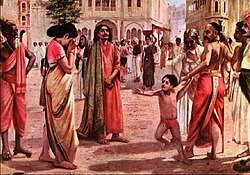The Release of Raja Harishchandra: A Landmark in Indian Cinema History
On May 3rd, 1913, a momentous event took place in the cultural history of India. It was the release of “Raja Harishchandra,” the first-ever Indian film. Directed by Dadasaheb Phalke, this silent film marked the inception of Bollywood and laid the foundation for the flourishing Indian film industry we know today.
The Birth of Indian Cinema Pioneer: Dadasaheb Phalke
Dadasaheb Phalke, often referred to as the father of Indian cinema, was a visionary who revolutionized the world of filmmaking in India. Inspired by the magic of motion pictures during a trip to London, Phalke was determined to bring this new form of entertainment to his homeland.
After facing numerous challenges and setbacks, Phalke finally released “Raja Harishchandra” in 1913. The film was a retelling of the ancient Indian legend of King Harishchandra and showcased Phalke’s exceptional storytelling skills and technical prowess.
The Significance of “Raja Harishchandra” in Indian Film History
“Raja Harishchandra” was not only a cinematic milestone but also a cultural phenomenon. It captured the imagination of the Indian audience and paved the way for the growth of the Indian film industry. The success of this silent film demonstrated the immense potential of Indian storytelling on the silver screen.
Despite the limited resources available at the time, Phalke managed to create a visually stunning film that resonated with the audience. The film’s success encouraged other filmmakers to explore the medium and contribute to the development of Indian cinema.
The Journey of Indian Cinema: From Silent Films to Bollywood
The release of “Raja Harishchandra” marked the beginning of a new era in Indian filmmaking. Silent films became the norm, and filmmakers experimented with various genres and storytelling techniques. The success of Phalke’s film inspired a wave of creativity and innovation in the industry.
As Indian cinema evolved, the silent era gave way to the advent of sound in the late 1920s. This technological advancement further enhanced the cinematic experience and opened up new possibilities for storytelling. Indian filmmakers embraced sound, and the era of talkies began.
With the introduction of sound, Indian cinema witnessed a surge in popularity and started gaining recognition on the global stage. The industry grew exponentially, and the term “Bollywood” emerged to describe the Hindi film industry based in Mumbai (formerly Bombay).
The Impact and Legacy of “Raja Harishchandra”
The release of “Raja Harishchandra” had a profound impact on Indian society. It not only entertained the masses but also served as a catalyst for social change. The film addressed important social issues and challenged prevailing norms, making it a powerful medium for cultural expression.
The success of “Raja Harishchandra” also inspired a new generation of filmmakers who sought to push the boundaries of Indian cinema. Their contributions shaped the industry and laid the groundwork for the diverse and vibrant film culture we see today.
As we look back on the 1913 release of “Raja Harishchandra,” we recognize its significance as a turning point in Indian film history. It was a testament to the passion and determination of Dadasaheb Phalke, who single-handedly pioneered the Indian film industry.
To learn more about the historical context and impact of “Raja Harishchandra,” you can refer to the following external references:
The release of “Raja Harishchandra” on May 3rd, 1913, will forever be remembered as a groundbreaking moment in Indian cinema. It paved the way for the rich and diverse cinematic tradition that continues to captivate audiences worldwide.

